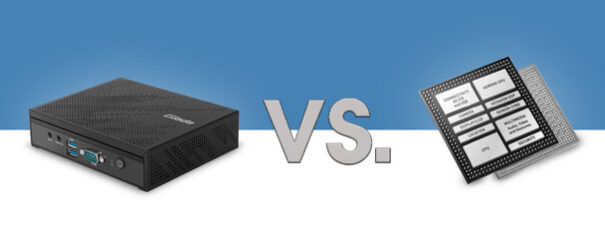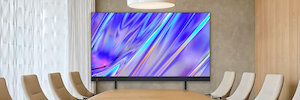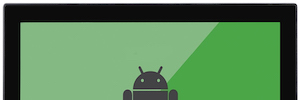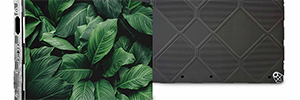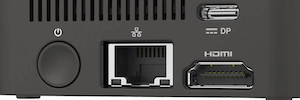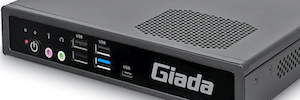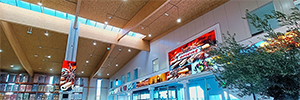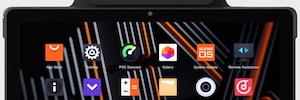Reproductor multimedia+display vs pantalla SoC
En esta columna de opinión, Pablo trains, Business Development Manager de Concept International Spain, explica porqué los integradores de sistemas de grandes redes de señalización digital apuestan por reproductores dedicados.
A la hora de comprar hardware de señalización digital, los integradores de sistemas tienen mucho donde elegir. Para la distribución de sus contenidos multimedia y HTML, pueden utilizar un reproductor multimedia dedicado con display o una pantalla con ‘sistema en un chip’ (SoC).
Mientras que con un reproductor multimedia se conectan externamente uno o varios monitores, con las llamadas pantallas SoC, la CPU, la GPU, la memoria y el sistema operativo están integrados en la placa de visualización y permanentemente incorporados al display. Estos sistemas no requieren un reproductor multimedia externo adicional.
Para el mundo de la señalización digital, ambas soluciones tienen su justificación. However, los integradores de sistemas de grandes redes apuestan sobre todo por reproductores dedicados. Por varias razones:
Son personalizables y configurables con flexibilidad
A diferencia de los sistemas SoC, los reproductores multimedia permiten ensamblar los componentes en función de los requisitos del cliente. Los usuarios pueden configurar sus reproductores para adaptarlos con precisión a diferentes aplicaciones y a un precio razonable.
Si el rendimiento no es suficiente, suele ser posible incluso una actualización. Los reproductores dedicados están especialmente indicados para los operadores de grandes redes de señalización digital con requisitos muy específicos de sistema operativo y configuración de hardware.
Las pantallas SoC tienen una configuración fija
Las pantallas SoC son sistemas propietarios con una configuración de componentes fija especificada por el fabricante. Los integradores no pueden modificar posteriormente el hardware instalado, por lo que tienen que trabajar con lo que ofrece el fabricante. Si una aplicación llega a su límite, por ejemplo con la CPU o la memoria, no es posible cambiar el reproductor multimedia y sustituirlo por otro más potente. Lo mismo ocurre con el sistema operativo.
Los integradores también deben tener en cuenta que no todas las plataformas de software son compatibles con el sistema operativo del SoC. El sistema de gestión de contenidos del fabricante también está predeterminado. Therefore, los proveedores de señalización digital deben estar familiarizados con el CMS del fabricante.
Algunos fabricantes de pantallas permiten al integrador de sistemas instalar su software de reproducción en el SoC Android gestionado por el propio fabricante. Esto requiere una gran experiencia en el manejo de los softwares, que pueden ser potencialmente incompatibles. Hay casos en los que el fabricante actualiza el sistema operativo en segundo plano y, therefore, bloquea involuntariamente el software del reproductor.
Siguen siendo flexibles en cuanto a software, actualizaciones y parches
Las actualizaciones de software en las pantallas SoC siempre se llevan a cabo de forma centralizada. Therefore, los proveedores de servicios de señalización digital deben confiar completamente en el fabricante para las actualizaciones y esperar que los agujeros de seguridad, que los hackers suelen utilizar como puerta de entrada, sean cerrados a tiempo de forma fiable por el fabricante.
Ofrecen una seguridad que cumple las normas de la empresa
Los integradores de sistemas pueden instalar ellos mismos nuevas versiones de software, actualizaciones o certificados de seguridad, o instalar programas antivirus y cortafuegos.
Esto significa que los reproductores multimedia dedicados siguen siendo flexibles y están bajo el control del integrador de sistemas o del proveedor de software de señalización digital en lo que respecta al software, las actualizaciones y los parches. Ellos deciden cuándo y cómo aplicar los parches y realizar el mantenimiento.
Lo que hay que tener en cuenta en términos de costes: Compra, instalación y reparación
Dado que el fabricante integra los módulos SoC en la pantalla, como un extra gratuito por así decirlo, el precio de compra de una pantalla SoC es menor que el de un reproductor multimedia –que suele costar entre 150 y 400 euros– y la pantalla. However, los usuarios suelen pagar después una licencia mensual de acceso al CMS que proporciona el fabricante a través de la nube, lo que relativiza claramente el ahorro en la compra.
A diferencia de los reproductores multimedia, los usuarios no necesitan instalar las pantallas SoC. No se requiere cableado adicional entre el reproductor y la pantalla, pues las conexiones ya están integradas en la pantalla y no hay cables entre el reproductor y el display. Dado que no se utiliza ningún reproductor multimedia externo, las pantallas SoC también pueden tener un menor consumo de energía.
Si se necesita una reparación, un reproductor multimedia externo puede sustituirse fácil y rápidamente con un tiempo de respuesta corto en caso de servicio. En el caso del SoC, es posible que la pantalla tenga que ser desmontada y reparada por una empresa certificada por el fabricante, normalmente a un coste elevado. En el peor de los casos, el sistema se sustituye por completo y el integrador tiene que aceptar que no estará disponible durante más tiempo. Para estos casos, debe tener en stock sistemas de repuesto, lo que supone un coste adicional.
Convencen en aplicaciones intensivas
Aunque el rendimiento de los sistemas SoC es cada vez mejor, no pueden hacer sombra a los reproductores multimedia en cuanto a potencia de cálculo y flexibilidad en la configuración de interfaces, performance, almacenamiento en disco duro o conectividad de red. Normally, se instala un reproductor básico con Android y una CPU poco potente. Este tipo de pantallas SoC manejan sin problemas aplicaciones estándar como la reproducción de contenidos Full HD en redes pequeñas o sistemas individuales.
Los reproductores multimedia dedicados, en cambio, ganan puntos sobre todo en redes grandes y con aplicaciones especialmente intensivas desde el punto de vista informático, como la interacción con pantallas táctiles y las visualizaciones 3D en tiempo real. Esto incluye también, For example, instalaciones con sensores IoT y aplicaciones analíticas.
Al separar la pantalla, el hardware y el software en los reproductores multimedia, los integradores no sólo tienen un gran margen de maniobra en su elección de componentes, sino que también pueden sustituirlos o actualizarlos fácilmente. This means that, en caso necesario, también se pueden hacer realidad nuevas ideas, posiblemente con requisitos mucho más exigentes.
Coexistencia de pantallas SoC y reproductores multimedia
Las pantallas SoC son ahora tan comunes como los reproductores multimedia en el creciente mercado de la señalización digital.
Dado que cada vez más proveedores de software del sector de la señalización digital ofrecen también su software de reproducción en SoC (por ejemplo LG WebOS, Samsung Tizen, Philips Android), los sistemas todo en uno altamente estandarizados seguirán ampliando su presencia en el mercado, aunque por el momento en redes más pequeñas o dispositivos individuales.
Para aplicaciones informáticas intensivas en grandes redes, el reproductor multimedia sigue teniendo una clara ventaja sobre el sistema SoC y se mantiene como el gran favorito. Therefore, cabe suponer que ambos sistemas seguirán coexistiendo en el mundo de la señalización digital en el futuro.
Encontrar el reproductor multimedia ideal
El reproductor multimedia ideal para aplicaciones de señalización digital deber ser tan robusto como un PC industrial y estar diseñado para un uso ininterrumpido. Los componentes electrónicos tienen que estar protegidos de las influencias electromagnéticas externas mediante una carcasa metálica con un buen comportamiento térmico. En cuanto al factor de forma, el reproductor debe pasar desapercibido detrás de pantallas, techos, paredes o en cajones y armarios.
Probablemente, el mejor factor de forma en este caso sea un reproductor dedicado que pueda insertarse en la pantalla desde el exterior. Es la simbiosis perfecta de ambos mundos: elección flexible del reproductor con una buena capacidad de servicio y una gran estabilidad y fiabilidad, ya que no hay que utilizar cables. Aquí hay dos estándares, OPS y SDM, iniciados por Intel. Prácticamente todos los fabricantes de grandes pantallas y proyectores tienen al menos una serie con ranura OPS o SDM.
Pablo trains
Business Development Manager de Concept International Spain
You liked this article?
Subscribe to us RSS feed And you won't miss anything.
• Section: Digital signage, Display, Signal distribution, Infrastructure, Gets



